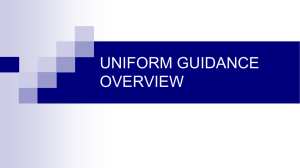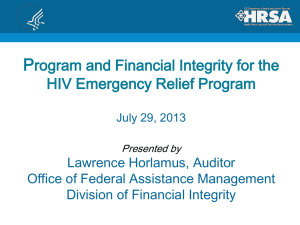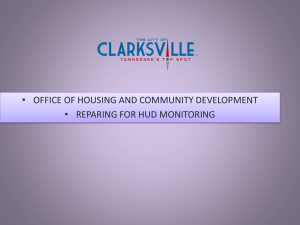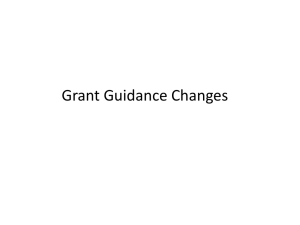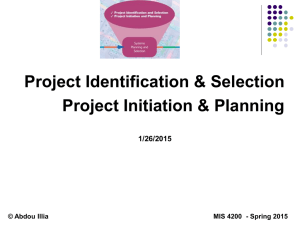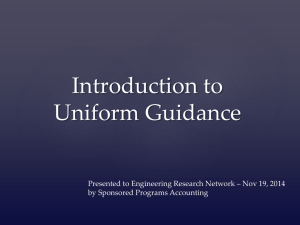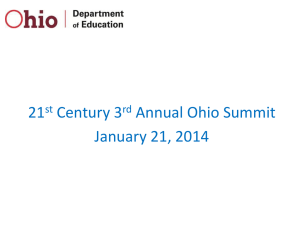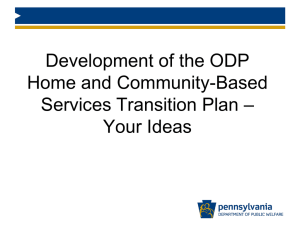2 CFR 200 - Ohio Department of Transportation
advertisement
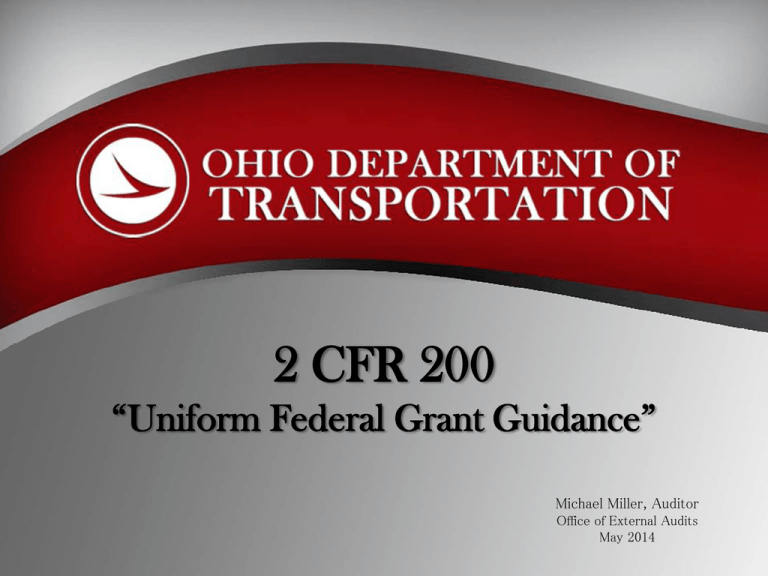
2 CFR 200 “Uniform Federal Grant Guidance” Michael Miller, Auditor Office of External Audits May 2014 Objectives and Background Objectives “The goal of this reform is to deliver on the President’s directives to (1) streamline our guidance for Federal awards to ease administrative burden and (2) strengthen oversight over Federal funds to reduce risks of waste, fraud, and abuse. Streamlining existing OMB guidance will increase the efficiency and effectiveness of Federal awards to ensure best use of the more than $500 billion expended annually….” 3 Background The Development of the Reform “This proposal reflects input from more than two years of work by the Federal and non-Federal financial assistance community led by the COFAR in response to the following two Presidential Directives:” “1. February 28, 2011, Presidential Memorandum on Administrative Flexibility, Lower Costs, and Better Results for State, Local, and Tribal Governments …” “2. Executive Order 13520 on Reducing Improper Payments …” 4 COFAR Council on Financial Assistance Reform About the COFAR “The COFAR, established by OMB Memorandum M-12-01, is comprised of an interagency group of Executive Branch officials to coordinate financial assistance. Council activities include providing recommendations to the Office of Management and Budget (OMB) on policies and actions necessary to effectively deliver, oversee, and report on grants and cooperative agreements, as well as sharing with executive departments and agencies (agencies) best practices and innovative ideas for transforming the delivery of this assistance. In addition, the Council will engage relevant stakeholders across Government on key issues to foster more efficient and effective Federal management by coordinating the development and implementation of standardized business processes, data standards, metrics, and information technology.” 6 Agency Members “The membership of the Council on Financial Assistance Reform consists of the: Controller of the Office of Management and Budget and senior policy officials from eight Federal agencies that provide the largest amounts of financial grants assistance and one additional agency that serves a two-year term to represent the perspective of other agencies that administer grants and cooperative agreements:” • • • • Department of Agriculture Department of Education Department of Energy Department of Health and Human Services • Department of Homeland Security • Department of Housing and Urban Development • Department of Labor • Department of Transportation Two-year Term Agency • National Science Foundation FY12-14 • Department of State FY 14-16 7 2 CFR 200 – What is it? TITLE 2 of the CODE OF FEDERAL REGULATIONS PART 200—UNIFORM ADMINISTRATIVE REQUIREMENTS, COST PRINCIPLES, AND AUDIT REQUIREMENTS FOR FEDERAL AWARDS 2 CFR 200 – Are these new regulations? As stated by OMB: “To deliver on the promise of a 21st-Century government that is more efficient, effective and transparent, the Office of Management and Budget is streamlining the Federal government’s guidance on Administrative Requirements, Cost Principles, and Audit Requirements for Federal awards. These modifications are a key component of a larger Federal effort to more effectively focus Federal resources on improving performance and outcomes while ensuring the financial integrity of taxpayer dollars in partnership with non-Federal stakeholders. This guidance provides a governmentwide framework for grants management which will be complemented by additional efforts to strengthen program outcomes through innovative and effective use of grantmaking models, performance metrics, and evaluation. This reform of OMB guidance will reduce administrative burden for non-Federal entities receiving Federal awards while reducing the risk of waste, fraud and abuse.” 9 2 CFR 200 – Are these new regulations? Primarily existing regulations – “This reform streamlines the language from eight existing OMB circulars into one consolidated set of guidance in the code of Federal regulations. This consolidation is aimed at eliminating duplicative or almost duplicative language in order to clarify where policy is substantively different across types of entities, and where it is not. As a result, the guidance includes sections and parts of sections which are clearly delineated by the type of non-Federal entity to which they apply.” 10 2 CFR 200 – Are these new regulations? “This final guidance does not broaden the scope of applicability from existing government-wide requirements, affecting Federal awards to nonFederal entities including state and local governments, Indian tribes, institutions of higher education, and nonprofit organizations. Parts of it may also apply to for-profit entities in limited circumstances and to foreign entities as described in this guidance and the Federal Acquisition Regulation. This guidance does not change or modify any existing statute or guidance otherwise based on any existing statute. This guidance does not supersede any existing or future authority under law or by executive order or the Federal Acquisition Regulation.” 11 2 CFR 200 – Are these new regulations? §200.104 Supersession. As described in §200.110 Effective/applicability date, this Part supersedes the following OMB guidance documents and regulations under Title 2 of the Code of Federal Regulations: (a) A-21, “Cost Principles for Educational Institutions” (2 CFR part 220); (b) A-87, “Cost Principles for State, Local and Indian Tribal Governments” (2 CFR part 225) and also Federal Register notice 51 FR 552 (January 6, 1986); (c) A-89, “Federal Domestic Assistance Program Information”; (d) A-102, “Grant Awards and Cooperative Agreements with State and Local Governments”; 12 2 CFR 200 – Are these new regulations? §200.104 Supersession. - continued (e) A-110, “Uniform Administrative Requirements for Awards and Other Agreements with Institutions of Higher Education, Hospitals, and Other Nonprofit Organizations” (codified at 2 CFR 215); (f) A-122, “Cost Principles for Non-Profit Organizations” (2 CFR part 230); (g) A-133, “Audits of States, Local Governments and Non-Profit Organizations,”; and (h) Those sections of A-50 related to audits performed under Subpart F—Audit Requirements of this part. 13 2 CFR 200 - Contents Subpart A Acronyms and Definitions §§ 200.0 > 200.99 14 2 CFR 200 - Contents Subpart B General Provisions §§ 200.100 > 200.113 15 2 CFR 200 - Contents Subpart C Pre-Federal Award Requirements and Contents of Federal Awards §§ 200.200 > 200.211 16 2 CFR 200 - Contents Subpart D Post Federal Award Requirements §§ 200.300 > 200.345 1. 2. 3. 4. 5. 6. 7. 8. 9. 10. Standards for Financial and Program Management Property Standards Procurement Standards Performance and Financial Monitoring and Reporting Subrecipient Monitoring and Management Record Retention and Access Remedies for Noncompliance Closeout Post-Closeout Adjustments and Continuing Responsibilities Collection of Amounts Due 17 2 CFR 200 - Contents Subpart E Cost Principles §§ 200.400 > 200.475 1. 2. 3. 4. 5. 6. General Provisions Basic Considerations Direct and Indirect (F&A) Costs Special Considerations for States, Local Governments and Indian Tribes Special Considerations for Institutions of Higher Education General Provisions for Selected Items of Cost 18 2 CFR 200 - Contents Subpart F Audit Requirements §§ 200.500 > 200.521 1. 2. 3. 4. 5. 6. General Audits Auditees Federal Agencies Auditors Management Decisions 19 2 CFR 200 - Appendices Appendix I Full Text of Notice of Funding Opportunity 20 2 CFR 200 - Appendices Appendix II Contract Provisions for Non-Federal Entity Contracts Under Federal Awards 21 2 CFR 200 - Appendices Appendix III Indirect (F&A) Costs Identification and Assignment, and Rate Determination for Institutions of Higher Education (IHEs) 22 2 CFR 200 - Appendices Appendix IV Indirect (F&A) Costs Identification and Assignment, and Rate Determination for Nonprofit Organizations 23 2 CFR 200 - Appendices Appendix V State/Local Government and Indian Tribe-Wide Central Service Cost Allocation Plans 24 2 CFR 200 - Appendices Appendix VI Public Assistance Cost Allocation Plans 25 2 CFR 200 - Appendices Appendix VII States and Local Government and Indian Tribe Indirect Cost Proposals 26 2 CFR 200 – Appendices - contd Appendix VIII Nonprofit Organizations Exempted From Subpart E—Cost Principles of Part 200 27 2 CFR 200 – Appendices - contd Appendix IX Hospital Cost Principles 28 2 CFR 200 – Appendices - contd Appendix X Data Collection Form (Form SF-SAC) 29 2 CFR 200 – Appendices - contd Appendix XI Compliance Supplement 30 2 CFR 200 – Effective Date §200.110 Effective/applicability date. (a) The standards set forth in this part which affect administration of Federal awards issued by Federal agencies become effective once implemented by Federal agencies or when any future amendment to this part becomes final. Federal agencies must implement the policies and procedures applicable to Federal awards by promulgating a regulation to be effective by December 26, 2014 unless different provisions are required by statute or approved by OMB. (b) The standards set forth in Subpart F—Audit Requirements of this part and any other standards which apply directly to Federal agencies will be effective December 26, 2013 and will apply to audits of fiscal years beginning on or after December 26, 2014. 31 2 CFR 200 – Effective Date - contd “Federal agencies must submit draft implementing regulations to OMB no later than six months from the date of publication of this guidance unless different provisions are required by statute or approved by OMB.” “Federal agencies will implement this guidance in unison, which will provide non- Federal entities with a predictable, transparent, and governmentwide consistent implementation schedule.” Again, as stated in subsection (a) publication of these Federal grantor agency implementing regulations is expected in the Federal Register on December 26, 2014. 32 2 CFR 200 on the Internet ELECTRONIC CODE OF FEDERAL REGULATIONS USER NOTICE The Electronic Code of Federal Regulations (e-CFR) is a currently updated version of the Code of Federal Regulations (CFR). It is not an official legal edition of the CFR. The e-CFR is an editorial compilation of CFR material and Federal Register amendments produced by the National Archives and Records Administration's Office of the Federal Register (OFR) and the Government Printing Office. The OFR updates the material in the e-CFR on a daily basis. The current update status appears at the top of all e-CFR web pages 34 ELECTRONIC CODE OF FEDERAL REGULATIONS http://www.ecfr.gov/cgi-bin/ECFR?page=browse Browse: Select: Title 2 – Grants and Agreements Select: Go Select: Hyperlink for 2 CFR 200 which is identified as: Title 2 Volume 1 Subtitle A Chapter II Part 200 – Office of Management and Budget Circulars 35 As Published in Federal Register http://www.gpo.gov/fdsys/pkg/FR-2013-12-26/pdf/2013-30465.pdf Federal Register Vol. 78 No. 248 Thursday December 26, 2013 Part III Office of Management and Budget 2 CFR Chapter 1, Chapter II, Part 200, et al. Uniform Administrative Requirements, Cost Principles, and Audit Requirements for Federal Awards; Final Rule 36 Training & Additional Resources Uniform Grant Guidance Crosswalks and Side-by-Sides 1. Uniform Guidance Crosswalk to Predominant Source in Existing Guidance 2. Uniform Guidance Crosswalk from Predominant Source in Existing Guidance 3. Uniform Guidance Definitions Text Comparison 4. Uniform Guidance Administrative Requirements Text Comparison 5. Uniform Guidance Cost Principles Text Comparison 6. Uniform Guidance Audit Requirements Text Comparison http://www.whitehouse.gov/omb/grants_docs 38 Training Webcasts Uniform Guidance 1-27-14 Training Webcasts 1. COFAR Training Intro 2. COFAR Training Administrative Requirements 3. COFAR Training Cost Principles 4. COFAR Training Audit Requirements 11minutes 1 hour 25 minutes 35 minutes 50 minutes https://cfo.gov/cofar/ 39 Frequently Asked Questions COFAR Releases Frequently Asked Questions On Wednesday, February 12, 2014, COFAR released the first set of FAQs in support of 2 C.F.R 200 Uniform Administrative Requirements, Cost Principles, and Audit Requirements for Federal Awards. Over two hundred thoughtful questions and comments have been received from grantors, grantees, and grant management and oversight professionals throughout country. Additional FAQ releases will parallel Federal agency submission of implementing regulations. If you have additional questions or comments please send them to cofar@omb.eop.gov. Visit https://cfo.gov/cofar/ https://cfo.gov/wp-content/uploads/2013/01/2-C.F.R.-200-FAQs-2-122014.pdf 40 Questions? Michael Miller, Auditor Ohio Department of Transportation, Division of Finance Office of External Audits, Mail Stop # 2140 1980 West Broad Street, 4th Floor Columbus, Ohio 43223 Ph: 614-466-0588 Fax: 614-887-4772 Michael.Miller@dot.state.oh.us In accordance with ODOT Central Office requirements, please ensure the Mail Stop number shown above is used when sending any correspondence to me via US Mail. http://www.dot.state.oh.us/Divisions/Finance/Auditing/Pages/default.aspx

